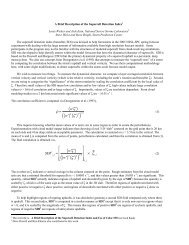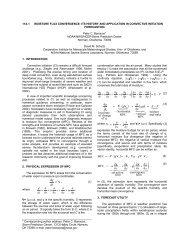2012 HWT Spring Forecast Experiment - Storm Prediction Center ...
2012 HWT Spring Forecast Experiment - Storm Prediction Center ...
2012 HWT Spring Forecast Experiment - Storm Prediction Center ...
You also want an ePaper? Increase the reach of your titles
YUMPU automatically turns print PDFs into web optimized ePapers that Google loves.
Melick,C.J, I.L. Jirak, A.R. Dean, J. Correia Jr, and S.J. Weiss, <strong>2012</strong>: Real Time Objective Verification of Convective <strong>Forecast</strong>s: <strong>2012</strong> <strong>HWT</strong><br />
<strong>Spring</strong> <strong>Forecast</strong> <strong>Experiment</strong>. Preprints, 37th Natl. Wea. Assoc. Annual Meeting, Madison, WI, Natl. Wea. Assoc., P1.52.<br />
––––––––––––––––––––––––––––––––––––––––––––––––––––––––––––––––––––––––––––––––––––––––––––––––––––––––––––––––––––<br />
P1.52 Real Time Objective Verification of Convective <strong>Forecast</strong>s:<br />
<strong>2012</strong> <strong>HWT</strong> <strong>Spring</strong> <strong>Forecast</strong> <strong>Experiment</strong><br />
CHRISTOPHER J. MELICK<br />
NOAA/NWS/NCEP/<strong>Storm</strong> <strong>Prediction</strong> <strong>Center</strong>, Norman, Oklahoma<br />
University of Oklahoma/CIMMS, Norman, Oklahoma<br />
ISRAEL L. JIRAK<br />
NOAA/NWS/NCEP/<strong>Storm</strong> <strong>Prediction</strong> <strong>Center</strong>, Norman, Oklahoma<br />
ANDREW R. DEAN<br />
NOAA/NWS/NCEP/<strong>Storm</strong> <strong>Prediction</strong> <strong>Center</strong>, Norman, Oklahoma<br />
JAMES CORREIA JR.<br />
NOAA/NWS/NCEP/<strong>Storm</strong> <strong>Prediction</strong> <strong>Center</strong>, Norman, Oklahoma<br />
University of Oklahoma/CIMMS, Norman, Oklahoma<br />
STEVEN J. WEISS<br />
NOAA/NWS/NCEP/<strong>Storm</strong> <strong>Prediction</strong> <strong>Center</strong>, Norman, Oklahoma<br />
ABSTRACT<br />
Objective forecast verification was conducted for the first time in near real-time during the <strong>2012</strong><br />
NOAA Hazardous Weather Testbed (<strong>HWT</strong>) <strong>Spring</strong> <strong>Forecast</strong>ing <strong>Experiment</strong> (<strong>2012</strong> SFE). One of the<br />
daily activities was to test the value of verification metrics by comparing the scores to subjective<br />
impressions of the participants. For this purpose, 1-km simulated reflectivity from high-resolution<br />
model and ensemble guidance was selected for examination. The evaluation was conducted via web<br />
pages using spatial plots for distinct time frames as well as a table which summarized statistical results.<br />
Feedback from the five-week period of the <strong>2012</strong> SFE indicated that the “neighborhood” techniques<br />
applied were more useful than grid point verification methods in the evaluation process, with the<br />
fractions skill score often rated as the most preferred metric.<br />
_______________<br />
1. Introduction<br />
The <strong>Storm</strong> <strong>Prediction</strong> <strong>Center</strong> (SPC) and<br />
National Severe <strong>Storm</strong>s Laboratory (NSSL) have<br />
jointly conducted the <strong>Spring</strong> <strong>Forecast</strong> <strong>Experiment</strong><br />
(SFE) every spring season to test new tools and<br />
__________<br />
techniques for improving the prediction of<br />
hazardous convective weather. Both Kain et al.<br />
(2003) and Clark et al. (<strong>2012</strong>b) provide a detailed<br />
history on the annual SFE from the first official<br />
program in 2000 through recent years after the<br />
move to the NOAA Hazardous Weather Testbed<br />
Corresponding author address: Christopher J. Melick, NOAA/NWS/NCEP <strong>Storm</strong> <strong>Prediction</strong> <strong>Center</strong>, 120 David L.<br />
Boren Blvd, Norman, OK 73072; E-mail: chris.melick@noaa.gov
(<strong>HWT</strong>) at the National Weather <strong>Center</strong>. Over the<br />
course of this time frame, the ultimate goal has been<br />
to foster collaboration between researchers and<br />
operational forecasters with the hope of transferring<br />
promising ideas from research into operations. In<br />
order to facilitate this process, evaluations of<br />
experimental model and human forecasts have<br />
consistently been a part of the daily activities, with<br />
<strong>2012</strong> SFE being no different. In previous SFEs,<br />
however, these assessments were done solely in a<br />
subjective fashion with objective metrics computed<br />
post-experiment (e.g., Kain et al. 2008).<br />
During the five-week period of the <strong>2012</strong> SFE<br />
(M-F; May 7 – June 8), objective verification of<br />
high-resolution model forecasts was conducted<br />
locally for the first time in near real-time. Because<br />
of its relevance to severe weather, simulated 1-km<br />
above ground level (AGL) reflectivity was evaluated<br />
using several convection-allowing models (CAMs) in<br />
both a deterministic and ensemble system<br />
framework. The focus in the current investigation was<br />
placed on testing the utility of a few selected verification metrics<br />
on high-resolution data by comparing those statistics to<br />
subjective evaluations from the participants. The goal is to<br />
refine the most useful approaches and measures for<br />
subsequent trials in the <strong>HWT</strong> and eventual<br />
application across the community to better assess<br />
high-resolution model performance.<br />
2. Data and Methodology<br />
a. Data<br />
The performance of many operational and<br />
experimental CAMs was explored rigorously during<br />
the <strong>2012</strong> SFE. All forecasts considered in the<br />
evaluation had grid spacing of about 4-km, were<br />
initialized daily at 00 UTC, and covered the 25<br />
weekdays from May 7 th – June 8 th . The verification<br />
of hourly output of 1-km simulated reflectivity was<br />
limited, however, to a 20-hour period (16-12 UTC)<br />
which corresponded to the time frame that<br />
experimental human forecasts were valid. These<br />
daily evaluations were also restricted to a mesoscale<br />
“area of interest” for possible severe convection. In<br />
order to define the spatial extent of the small<br />
domain, surface weather stations listed in Table 1<br />
served as movable center points for locations across<br />
the United States.<br />
Table 1. Description of the surface weather stations selected for each<br />
of the 25 days as center-points during <strong>2012</strong> SFE. All of the daily<br />
evaluations were restricted to a mesoscale “area of interest” for possible<br />
severe convection. This small domain was movable to locations in the<br />
eastern and central United States. Consult Fig. 1 for an example plot<br />
showing the spatial extent.<br />
<strong>Center</strong>-point<br />
Date[ YYMMDD] 3-char ID<br />
Station Name, State<br />
120507 BMQ Burnet, TX<br />
120508 SJT San Angelo, TX<br />
120509 AGS Augusta/Bush, GA<br />
120510 SAT San Antonio, TX<br />
120511 SAT San Antonio, TX<br />
120514 DRT Del Rio, TX<br />
120515 RAC Racine, WI<br />
120516 RUT Rutland State, VT<br />
120517 GBD Great Bend, KS<br />
120518 MBG Mobridge, SD<br />
120521 CDS Childress, TX<br />
120522 MBG Mobridge, SD<br />
120523 BVN Albion Municipal, NE<br />
120524 RGK Red Wing, MN<br />
120525 ICT Witchita, KS<br />
120528 ORD Chigao O'Hare, IL<br />
120529 OKC Oklahoma City, OK<br />
120530 END Enid/Vance AFB, OK<br />
120531 MSL Muscle Shoal, AL<br />
120601 AVC South Hill/Meckl, VA<br />
120604 BZN Bozeman, MT<br />
120605 LGC La Grange, GA<br />
120606 LBF North Platte, NE<br />
120607 TIF Thedford/Thomas, NE<br />
120608 2WX Buffalo, SD<br />
1) DETERMINISTIC MODELS AND ENSEMBLES<br />
Table 2 provides a description of the two<br />
deterministic models used in the examination.<br />
These models were chosen based on ease of<br />
accessibility and to compare a relatively new 4-km<br />
model to one that has been examined at the SPC for<br />
several years. One model was the WRF-ARW<br />
version produced in real time at NSSL (hereafter<br />
referred to as NSSL-WRF; Sobash et al. 2011).<br />
Since late 2006, forecasts out to 36-hours from this<br />
4-km CAM have been directly transmitted to SPC.<br />
More recently in 2011, National <strong>Center</strong>s for<br />
Environmental <strong>Prediction</strong> (NCEP) began running<br />
the Nonhydrostatic Multiscale Model on a rotated,<br />
Arakawa B-grid (NMMB) in the North American<br />
Mesoscale (NAM) slot, replacing the WRF-NMM<br />
framework. One-way, higher resolution nests are<br />
possible in this new framework using lateral<br />
boundary conditions (LBCs) from the 12-km<br />
NMMB parent. A 4-km nest (hereafter referred to<br />
as NAM-Nest) was used for comparison during the<br />
<strong>2012</strong> SFE.<br />
2
Table 3 describes configuration specifics for<br />
three different storm-scale ensembles considered in<br />
investigating ensemble probability thresholds of<br />
simulated reflectivity. As had been the case since<br />
2007, the University of Oklahoma (OU) <strong>Center</strong> for<br />
Analysis and <strong>Prediction</strong> of <strong>Storm</strong>s (CAPS) supplied<br />
the SFE with data from their 4-km grid length<br />
storm-scale ensemble forecast (SSEF) system. The<br />
SSEF employs three dynamical cores (ARW, NMM,<br />
ARPS) and is a multi-initial condition (IC), multilateral<br />
boundary condition (LBC), and multi-physics<br />
system with 12 core members included in the postprocessed<br />
ensemble products (Clark et al. <strong>2012</strong>a).<br />
As a practical alternative, SPC developed the stormscale<br />
ensemble of opportunity (SSEO) in 2011 by<br />
processing five existing deterministic CAMs (Jirak et<br />
al. <strong>2012</strong>). Although SPC has limited control over its<br />
configuration, the SSEO remains attractive because<br />
of the minimal computational costs involved.<br />
Finally, a direct feed to SPC from the Air Force<br />
Weather Agency (AFWA) allowed the testing of<br />
their operational, 10-member 4-km WRF-ARW<br />
ensemble. The multi-IC/LBCs of the AFWA<br />
storm-scale ensemble are comprised from various,<br />
downscaled global model forecasts (Clark et al.<br />
<strong>2012</strong>a).<br />
Table 2. Configuration of the 00Z initialized deterministic CAMs used<br />
in <strong>2012</strong> SFE study.<br />
Model<br />
Grid<br />
Spacing<br />
Vert.<br />
Levels<br />
Time<br />
Step<br />
Fcst.<br />
Length<br />
PBL<br />
Micro<br />
NSSL-WRF 4-km 35 24 s 36 h MYJ WSM6<br />
NAM-Nest 4-km 60 8.89 s 60 h MYJ Ferrier<br />
Table 3. Configuration of the 00Z initialized storm-scale ensembles<br />
used in <strong>2012</strong> SFE study.<br />
Ensemble<br />
Grid<br />
Spacing<br />
Core #<br />
Members<br />
Fcst.<br />
Length<br />
SSEO 4-5 km 7 36 h<br />
AFWA 4-km 10 72 h<br />
SSEF 4-km 12 36 h<br />
2) VERIFICATION DATA<br />
Reference<br />
Jirak et al.<br />
(<strong>2012</strong>)<br />
Clark et al.<br />
(<strong>2012</strong>a)<br />
Clark et al.<br />
(<strong>2012</strong>a);<br />
Kong et al.<br />
(<strong>2012</strong>)<br />
Verification of high-resolution reflectivity<br />
forecasts was performed using gridded radar<br />
observations of mosaic hybrid-scan reflectivity from<br />
the National Mosaic and Multi-Sensor QPE (NMQ)<br />
System (Zhang et al. 2011). Given the very fine<br />
resolution (0.01x0.01 degree) of the NMQ, a direct<br />
one-to-one comparison was achieved through<br />
interpolation of all the data onto common GEMPAK<br />
(GEneral Meteorological PAcKage; desJardins et al.,<br />
1991) grids (one for deterministic model evaluation<br />
and one for the ensemble component. For the<br />
statistical analysis, a mask was also applied to ignore<br />
grid points outside of the contiguous United States<br />
for those days when the mesoscale “area of interest”<br />
included such regions.<br />
b. Methodology: Verification Metrics and Techniques<br />
The verification process required creation of<br />
forecast- and observed-storm grid points from the<br />
reflectivity by specifying a threshold, in this case ≥40<br />
dBZ. A traditional (i.e., “at-the-grid point”) method<br />
was used as one way for evaluating the deterministic<br />
CAMs. In this case, a 2x2 contingency table (Wilks<br />
2006) was constructed from the binary (yes/no) event<br />
grids. After counts of hit, misses, false alarms, and<br />
correct nulls were obtained each forecast hour, some<br />
standard verification metrics were computed (Critical<br />
Success Index [CSI] and Gilbert Skill Score [GSS] –<br />
also known as Equitable Threat Score).<br />
Validating “grid-point” to “grid-point” is<br />
inherently problematic, though, when considering the<br />
occurrence of a relatively rare weather phenomenon<br />
(e.g., thunderstorm; Ebert 2009). Instead, a better<br />
technique to account for spatial uncertainty relies on<br />
setting a radius of influence (ROI) to incorporate a<br />
“neighborhood” around each grid point. A 40-km<br />
ROI was used for the current investigation to be<br />
consistent with SPC Convective Outlooks (i.e., within<br />
25 miles of a point). Thus, the goal was to evaluate<br />
measures that account for spatial uncertainty in the<br />
forecasts.<br />
Roberts and Lean (2008) and Schwartz et al.<br />
(2010) described a process for calculating<br />
“neighborhood” fractional probabilities from a single<br />
model. By applying their formula to the NSSL-WRF<br />
and NAM-Nest at each grid point, the number of<br />
grid boxes with 1-km AGL simulated reflectivity ≥ 40<br />
dBZ within a 40-km ROI was divided by the total<br />
number of boxes within that “neighborhood”. As a<br />
result, a smoother field is obtained which shows<br />
predicted coverage of storms as opposed to precise<br />
placement or intensity of localized features. The<br />
same technique was then utilized to form<br />
corresponding probabilistic fields for the<br />
observations. For the fractions skill score (FSS;<br />
Schwartz et al. 2010), fractional coverage values of<br />
3
the observations and models were directly compared .<br />
Alternatively, CSI was calculated at a threshold of<br />
10% for comparison among the models and<br />
ensembles.<br />
Ensemble probabilities of an event occurrence<br />
were examined using the SSEO, AFWA, and SSEF<br />
systems. In this case, the probabilities were computed<br />
as the fraction of members with one or more grid<br />
points meeting or exceeding the threshold (40 dBZ)<br />
within the ROI (40-km). Harless (2010) introduced<br />
this concept as a binary neighborhood ensemble<br />
probability (BNEP) and found it to be skillful in<br />
quantifying forecast uncertainty associated with<br />
severe weather outbreaks. Similar to her work, a 2-D<br />
Gaussian kernel operator was also utilized with the<br />
weighting function set to 10 grid points, thereby<br />
effectively spreading the response to a 40-km<br />
distance. This acted to smooth the ensemble<br />
probabilities and create spatial probability<br />
distributions for the observed events given that there<br />
was only one source of radar data (i.e., 100%<br />
probability of occurrence). Again, an objective<br />
evaluation was performed by using CSI and FSS each<br />
forecast hour for the storm-scale ensembles.<br />
3. Results<br />
a. <strong>2012</strong> SFE Website<br />
The afternoon evaluation component of the daily<br />
activities in the <strong>HWT</strong> sought participant feedback in<br />
comparing the verification metrics with their<br />
subjective impressions of the high-resolution model<br />
forecast performance. To facilitate a simple and quick<br />
diagnosis, the various forecast metrics were available<br />
on the <strong>2012</strong> SFE website<br />
(http://hwt.nssl.noaa.gov/<strong>Spring</strong>_<strong>2012</strong>/) for nextday<br />
evaluations. Time-matched images of forecasts<br />
and observations were created and displayed on web<br />
pages with the option to overlay the computed<br />
statistics. In order to illustrate this functionality,<br />
example snapshots highlighting ensemble and<br />
deterministic model plot comparisons are presented<br />
in Figs. 1 and 2, respectively.<br />
In addition, the SFE participants were able to get<br />
a summary of the hourly objective results for a<br />
particular day in a tabular format. The table creation<br />
(Fig. 3) was driven on a separate web page by the<br />
choice of a date, verification method summary, and<br />
verification metric selected from a drop down menu.<br />
To cover an overall analysis for all five weeks, another<br />
summary table was also made available for examining<br />
trends across multiple days (Fig. 4), which was<br />
offered through dynamic calculation in PHP.<br />
Figure 1. Sample spatial plots from <strong>2012</strong> SFE website illustrating the<br />
ability to overlay verification metric scores for storm-scale ensemble<br />
guidance. The ensemble probabilistic forecasts for 1-km simulated<br />
reflectivity are valid at 23Z on June 1 st , <strong>2012</strong> for a mesoscale “area of<br />
interest” centered over south-central VA. The upper-left panel shows<br />
the CAPS SSEF, the upper-right shows the SPC SSEO, the lower-left<br />
displays the AFWA ensemble, with the observations of hybrid-scan<br />
reflectivity from the NMQ system located in the lower right. Beneath<br />
each forecast, the corresponding CSI and FSS are displayed as well.<br />
The figure is annotated to highlight the date, forecast time, and type of<br />
display.<br />
Figure 2. Similar to Fig. 1 except for deterministic guidance from the<br />
NSSL-WRF (left panels) and NAM-Nest (middle panels) models. The<br />
raw 1-km AGL simulated reflectivity is displayed in the top row of plots<br />
while probabilities from a fractional “neighborhood” approach are given<br />
in the bottom row. The verifying observations on the far right again<br />
come from the NMQ system. Besides computing CSI for verification at<br />
the grid point, the traditional verification metrics displayed in the top<br />
row also include Gilbert Skill Score (GSS).<br />
4
. Multiple Day <strong>Forecast</strong> Verification Metrics<br />
Figure 3. Sample composite of several tables created from <strong>2012</strong> SFE<br />
website which summarizes daily verification metrics for 1-km AGL<br />
simulated reflectivity. The table is created from a variety of user<br />
options: choice of a date, the type of verification method summary, and<br />
selection from a drop down list of skill scores (CSI being the default).<br />
Skill score results are binned by forecast hours (columns) from 16Z-12Z<br />
and models/ensemble systems (rows). The three tables displayed in this<br />
example from June 1 st , <strong>2012</strong> are CSI values for grid point comparison of<br />
deterministic models (top), FSS values using a fractional<br />
“neighborhood” method of deterministic models (middle), and FSS<br />
values from an evaluation of storm-scale ensemble probabilities. Again,<br />
annotation is used to emphasize some options and functionality.<br />
Figure 5 shows the accumulated multiple day<br />
forecast verification metrics for simulated reflectivity.<br />
The FSS from all three storm-scale ensemble systems<br />
(SSEO, AFWA, SSEF) surpassed the skill value of 0.5<br />
with the SSEO even exceeding 0.6. The accumulated<br />
CSI results ranged from a little above 0.3 for AFWA<br />
to slightly over 0.4 with SSEO (Fig. 5). The skill<br />
scores were much lower for the deterministic CAMs.<br />
Still, a noticeable distinction existed as the fractional<br />
“neighborhood” CSI and FSS revealed higher values<br />
than the traditional, grid-point CSI and GSS.<br />
Between the latter two metrics, grid-point GSS was<br />
slightly worse but both showed values near zero.<br />
When comparing the verification metrics amongst the<br />
deterministic CAMs, the NSSL-WRF had higher<br />
values than the NAM-Nest.<br />
Similar multiple-day statistics by forecast hour are<br />
displayed in Fig. 6. From this perspective, the<br />
separate panels present trend lines from 16-12 UTC<br />
for all of the methods and verification metrics<br />
investigated. Results indicated that the maximum<br />
skill often occurred in mid-afternoon when<br />
convective activity was generally at its peak across the<br />
mesoscale “area of interest”. Generally, the stormscale<br />
ensemble performance peak was higher and<br />
broader than the deterministic CAMs. For the latter,<br />
all four metrics showed low skill scores for all<br />
forecast hours with the fractional “neighborhood”<br />
approach showing the highest value near 0.25 at 20<br />
UTC (middle right panel in Fig. 6). When comparing<br />
the two deterministic CAMs, the NSSL-WRF usually<br />
performed better for most forecast hours. With<br />
respect to the ensembles, the SSEO FSS revealed the<br />
highest skill values ranging from 0.6 to 0.7 (bottom<br />
right panel in Fig. 6).<br />
Figure 4. Similar to Fig. 3 except for tables created from the <strong>2012</strong> SFE<br />
website showcasing multiple day statistical overview. In this case, the<br />
daily accumulated scores from each day are presented, with the right<br />
most column representing the final outcome accumulated over the<br />
entire twenty five days of the <strong>2012</strong> SFE (5/7/<strong>2012</strong> – 6/8/<strong>2012</strong>).<br />
5
c. Daily Distribution of <strong>Forecast</strong> Verification Metrics<br />
Figure 5. Multiple day accumulated skill scores for 1-km AGL<br />
simulated reflectivity from the 25 days (5/7/<strong>2012</strong> – 6/8/<strong>2012</strong>) of the<br />
<strong>2012</strong> SFE. The following verification metrics are presented in this<br />
graph: CSI/GSS for traditional grid-point comparisons of deterministic<br />
models, CSI/FSS for fractional “neighborhood” comparisons of<br />
deterministic models, and CSI/FSS for evaluation of storm-scale<br />
ensemble systems. It should be noted that the AFWA ensemble data<br />
was unavailable for three days with the CAPS SSEF ensemble data<br />
missing for one.<br />
The findings thus far have been accumulated<br />
over the entire five week period of the <strong>2012</strong> SFE.<br />
To get an indication of the variability in daily skill<br />
scores, separate box-and-whisker plots for the<br />
deterministic (Fig. 7) and ensemble (Fig. 8) forecasts<br />
were produced. All of the percentile rankings for<br />
grid-point CSI and GSS were close to zero (top panel<br />
in Fig. 7). The distribution in FSS displayed a wider<br />
range (bottom panel in Fig. 7) and a predominant<br />
upward shift in the distribution of the NSSL-WRF<br />
results compared to the NAM-Nest. An examination<br />
of CSI and FSS from the ensemble in Fig. 8 suggests<br />
a substantial overlap amongst all three storm-scale<br />
ensembles. Nevertheless, AFWA subjectively<br />
showed a tendency to be an outlier and have more<br />
forecasts with lower scores, this being implied by the<br />
lower 25 th percentile value for FSS.<br />
Figure 7. Box and whisker plots of daily accumulated skill scores for 1-<br />
kmAGL simulated reflectivity from deterministic model solutions. The<br />
top (bottom) row presents results from the traditional grid-point<br />
(“neighborhood”) method. The whiskers correspond to the 10 th and<br />
90 th percentile rankings from the 25 days during <strong>2012</strong> SFE.<br />
Figure 6. <strong>2012</strong> SFE multiple day accumulated skill scores by forecast<br />
hour for 1-km AGL simulated reflectivity. Multiple panels display<br />
diurnal trend lines for deterministic model evaluations at the grid point<br />
[CSI (top left) and GSS (top right)] and from a fractional<br />
“neighborhood” approach [CSI (middle left) and FSS (middle right).<br />
The bottom two panels show forecast hour trend lines for storm-scale<br />
ensemble metrics [CSI (left) and FSS (right)].<br />
6
indicated that it was preferred over the other metrics.<br />
Finally, feedback suggested that the ensemble CSI<br />
and FSS from the BNEP method was consistent with<br />
the subjective impressions of the participants for well<br />
over half of the five week period.<br />
Figure 8. Box and whisker plots of daily accumulated skill scores for 1-<br />
km AGL simulated reflectivity from storm-scale ensemble systems. The<br />
top (bottom) row presents results from the FSS (CSI). The whiskers<br />
correspond to the 10 th and 90 th percentile rankings for <strong>2012</strong> SFE but the<br />
sample size is smaller for the AFWA (22 days) and CAPS SSEF (24<br />
days) systems.<br />
d. Participant Feedback<br />
Another major purpose of the research was to<br />
compare the participant feedback to the objective<br />
results for 1-km AGL simulated reflectivity. Figures<br />
9 and 10 present tallies gathered from the responses<br />
on 23 days of forecast verification technique/metric,<br />
respectively. While there were occasional<br />
differences, subjective impressions typically matched<br />
objective results during the <strong>2012</strong> SFE daily evaluation<br />
activity. In particular, the NAM-Nest was frequently<br />
rated “Worse” to “Much Worse” than the NSSL-<br />
WRF, and the SSEO forecasts received the most<br />
ratings of “Good” (Fig. 9). One of the discrepancies<br />
was the subjective ranking of the SSEF with respect<br />
to the AFWA ensemble. Here, AFWA was rated<br />
“Good” more often than SSEF and rated “Poor” or<br />
“Very Poor” less often than SSEF (Fig. 9) while the<br />
objective metrics preferred the SSEF over the<br />
AFWA.<br />
Most importantly, the forecast verification<br />
metrics with the deterministic CAMs “Agreed” to<br />
“Strongly Agreed” with the subjective impressions<br />
more so for the fractional “neighborhood” technique<br />
than the grid point approach (Fig. 10). With regard<br />
to the best metric from the deterministic forecasts,<br />
the 13 day tally for fractional “neighborhood” FSS<br />
Figure 9. Participant feedback tallies gathered during <strong>2012</strong> SFE daily<br />
activity evaluation. The results obtained from the two survey questions<br />
covered subjective comparisons of 1-km reflectivity from deterministic<br />
models (top graph) and storm-scale ensemble systems (bottom graph).<br />
The wording of the questions is given as: “Deterministic Reflectivity:<br />
Subjectively compare the model generated forecasts during 16-12UTC<br />
from the NMMB Nest to the NSSL-WRF” and “Ensemble Reflectivity:<br />
Subjectively rate the model generated forecasts during 16-12UTC<br />
ranging from Very Good to Very Poor”. The sample size was 23 since<br />
no evaluations were performed on Memorial Day (5/28/<strong>2012</strong>) nor the<br />
very last day (6/8/<strong>2012</strong>) of the <strong>2012</strong> SFE.<br />
7
grid point methods. The FSS was often rated the<br />
most preferred metric, with the accumulated daily and<br />
multiple daily results continuously showing the<br />
highest values. The skillful scores (values over 0.5)<br />
from the SSEO, SSEF, and AFWA indicate the<br />
usefulness of a probabilistic approach through the use<br />
of ensembles. Future plans for the 2013 SFE include<br />
possibly incorporating more probability thresholds to<br />
CSI, allow for timing uncertainty between the<br />
forecasts and observations, and exploring the use of<br />
different ROI.<br />
Figure 10. Same as in Fig. 9 except for survey questions relevant to<br />
assessing the forecast verification metrics examined from the<br />
deterministic models (top two graphs) and storm-scale ensemble<br />
systems (bottom graph). The wording of the questions is given as:<br />
“Deterministic Reflectivity: Do the objective metrics agree with your<br />
subjective impressions of forecast skill? Were the fractional<br />
neighborhood metrics better objective measures than grid point metrics<br />
on this day?”, “Deterministic Reflectivity: Which objective metric best<br />
agreed with perceived forecast skill on this day?”, and “Ensemble<br />
Reflectivity: Do the objective metrics agree with your subjective<br />
impressions of forecast skill?”.<br />
4. Summary and Conclusions<br />
SPC conducted objective verification of highresolution<br />
model forecasts of 1-km AGL simulated<br />
reflectivity during the <strong>2012</strong> SFE in near real-time.<br />
This provided the opportunity to assess the utility of<br />
selected verification metrics in relation to subjective<br />
evaluations of model performance. Time-matched<br />
spatial plots of forecasts and observations were<br />
displayed on the SFE <strong>2012</strong> webpage for visual<br />
comparison. Unlike prior years, however, objective<br />
skill scores were also calculated for each forecast<br />
time period and overlaid with the appropriate<br />
images as well as included in table summaries.<br />
A major finding was that the “neighborhood”<br />
objective measures best agreed with the subjective<br />
evaluations for the majority of the five week period.<br />
In particular, feedback from participants indicated<br />
that utilizing a “neighborhood” technique was usually<br />
better than evaluating high-resolution models using<br />
Acknowledgements. This research was supported by an<br />
allocation of advanced computing resources provided by<br />
the National Science Foundation. The computations for<br />
the CAPS SSEF were performed on Kraken (a Cray XT5)<br />
at the National Institute for Computational Science<br />
(NICS; http://www.nics.tennessee.edu/). We would like<br />
to thank Ming Xue, Fanyou Kong, and Kevin Thomas<br />
from OU CAPS for generating and providing SSEF data<br />
and Jack Kain and Patrick Marsh of NSSL for making the<br />
data available to SPC. Evan Kuchera and Scott<br />
Rentschler of AFWA generously provided AFWA data.<br />
We would also like to thank the participants from the<br />
<strong>2012</strong> SFE for providing useful feedback for this<br />
evaluation.<br />
REFERENCES<br />
Clark, A.J, and Coauthors, <strong>2012</strong>a: <strong>Spring</strong> <strong>Forecast</strong>ing<br />
<strong>Experiment</strong> <strong>2012</strong> Program Overview and<br />
Operations Plan. [Available online at<br />
http://hwt.nssl.noaa.gov/<strong>Spring</strong>_<strong>2012</strong>/OPS_plan_d<br />
raft.pdf<br />
________, and Coauthors, <strong>2012</strong>b: An Overview of the<br />
2010 Hazardous Weather Testbed <strong>Experiment</strong>al<br />
<strong>Forecast</strong> Program <strong>Spring</strong> <strong>Experiment</strong>. Bull. Amer.<br />
Meteor. Soc., 93, 55–74.<br />
desJardins, M.L., K.F. Brill, and S.S. Schotz, 1991: Use of<br />
GEMPAK on Unix workstations, Proc. 7th<br />
International Conf. on Interactive Information and Processing<br />
Systems for Meteorology, Oceanography, and Hydrology, New<br />
Orleans, LA, Amer. Meteor. Soc., 449-453.<br />
Ebert, E.E., 2009: Neighborhood verification: A strategy<br />
for rewarding close forecasts. Wea. <strong>Forecast</strong>ing, 24,<br />
1498–1510.<br />
Harless, A.R., 2010: A report-based verification study of<br />
the CAPS 2008 storm-scale ensemble forecasts for<br />
severe convective weather. M.S. Thesis, School of<br />
Meteorology, University of Oklahoma, 143 pp.<br />
8
Jirak, I.L, S.J. Weiss, and C.J. Melick, <strong>2012</strong>: The SPC<br />
<strong>Storm</strong>-Scale Ensemble of Opportunity: Overview<br />
and results from the <strong>2012</strong> Hazardous Weather<br />
Testbed <strong>Spring</strong> <strong>Forecast</strong>ing <strong>Experiment</strong>. 26th Conf.<br />
Severe Local <strong>Storm</strong>s, Nashville, TN, Amer. Meteor.<br />
Soc., Paper P9.137.<br />
Kain, J.S., P.R. Janish, S.J. Weiss, R.S. Schneider, M.E.<br />
Baldwin, and H.E. Brooks, 2003: Collaboration<br />
between forecasters and research scientists at the<br />
NSSL and SPC: The <strong>Spring</strong> Program. Bull. Amer.<br />
Meteor. Soc., 84, 1797–1806.<br />
____, S.J. Weiss, D.R. Bright, M.E. Baldwin, J.J. Levit,<br />
G.W. Carbin, C.S. Schwartz, M.L. Weisman, K.K.<br />
Droegemeier, D.B. Weber, and K.W. Thomas, 2008:<br />
Some practical considerations regarding horizontal<br />
resolution in the first generation of operational<br />
convection allowing NWP. Wea. <strong>Forecast</strong>ing, 23, 931-<br />
952.<br />
Roberts, N.M., and H.W. Lean, 2008: Scale-selective<br />
verification of rainfall accumulations from highresolution<br />
forecasts of convective events. Mon. Wea.<br />
Rev., 136, 78–97.<br />
Schwartz, C. S., and Coauthors, 2010: Toward improved<br />
convection-allowing ensembles: model physics<br />
sensitivities and optimizing probabilistic guidance<br />
with small ensemble membership. Wea. <strong>Forecast</strong>ing,<br />
25, 263–280.<br />
Sobash, R.A., J.S. Kain, D.R. Bright, A.R. Dean, M.C.<br />
Coniglio, S.J. Weiss, 2011: Probabilistic forecast<br />
guidance for severe thunderstorms based on the<br />
identification of extreme phenomena in convectionallowing<br />
model forecasts. Wea. <strong>Forecast</strong>ing, 26, 714–<br />
728.<br />
Wilks, D.S., 2006: <strong>Forecast</strong> Verification. Statistical methods<br />
in the atmospheric sciences, 2 nd Edition. Academic Press,<br />
260-268.<br />
Zhang, Jian, and Coauthors, 2011: National Mosaic and<br />
Multi-Sensor QPE (NMQ) System: Description,<br />
results, and future plans. Bull. Amer. Meteor. Soc., 92,<br />
1321–1338.<br />
9



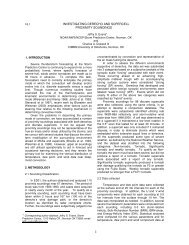
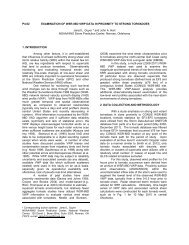
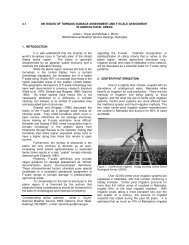
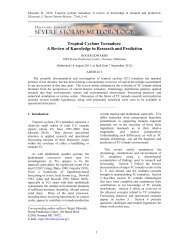


![NSWW_ROC_Overview.ppt [Read-Only] - Storm Prediction Center ...](https://img.yumpu.com/26478320/1/190x146/nsww-roc-overviewppt-read-only-storm-prediction-center-.jpg?quality=85)
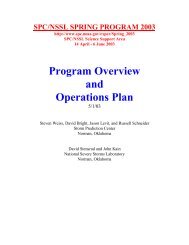
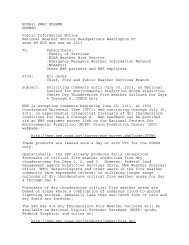
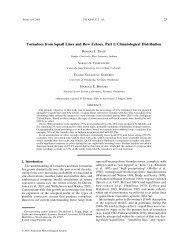

![NEW_PRODUCTS_imy.ppt [Read-Only] - Storm Prediction Center ...](https://img.yumpu.com/26478296/1/190x146/new-products-imyppt-read-only-storm-prediction-center-.jpg?quality=85)
